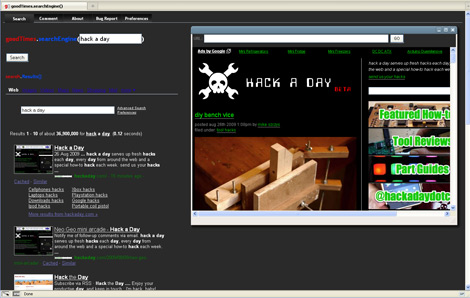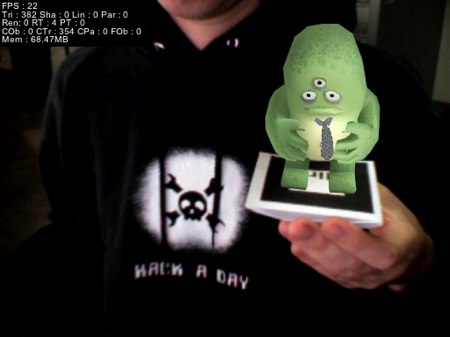

__ __ __ ___ / // /__ _____/ /__ ___ _ / _ \___ ___ __ / _ / _ `/ __/ '_/ / _ `/ / // / _ `/ // / /_//_/\_,_/\__/_/\_\ \_,_/ /____/\_,_/\_, / retro edition /___/Now optimized for embedded devices!
| About | Successes | Retrocomputing guide | Email Hackaday |

[Erik] was looking for a sturdy robotics platform and was initially considering the iRobot Create, until he found that he could score a Roomba Discovery series for a fraction of the price. The Discovery includes a battery, which is missing from the iCreate, though it also has all of the standard vacuum OK +IPD,0,1024: bits included as well.
He immediately removed all of the vacuum parts once he got his hands on the Roomba, and began adding the support structure to house the rest of his robot’s components. The robot is controlled via a small laptop which sits on top of the Roomba’s base, and features a panning and telescoping webcam to provide feedback to the operator.
The robot has been under construction for a little over a year now, and has had a few upgrades over that time. The original laptop was swapped out for a newer dual-core model, and the webcam was upgraded to a model featuring motion tracking. The whole thing has been skinned in thin sheet metal for a sleek look, and he has added a servo-driven arm as well.
The project is not quite complete, and he hasn’t really stated what he plans on using the robot for, but it looks good so far – we can’t wait to see it when it’s finished.
Now that the CCC is over, we finally dug ourselves out of a ginormous pile of cables (Kabelsalat ist gesund
OK
+IPD,0,1024:!) to bring you this round up post about the best stuff from the last two days of the con.
First up on day 10 was I See Airplanes!, Eric Blossom’s excellent speech on creating hardware for making homebrew radars and software using the GnuRadio project. He uses bistatic passive receivers in the 100 MHz range doing object detection using other peoples’ transmitters. The project has a lot yet to accomplish including the use of helical filters (if there are any antenna freaks reading this, contact Eric, he’s looking for a bit of help).
Next on the third day we attended Ilja van Sprundel‘s huge fuzzing extravaganza. Fuzzers generate bad data that is designed to look like go OK +IPD,0,1024:od data and will hopefully break something in an interesting way. Our fav part? When the list of irc clients broken by his ircfuzz tool was so long he had to use 10pt font to get it all on one slide (see slide 53)! His paper can be found here and the slides here.
We then wandered to Harald Welte‘s talk on hacking the Motorola EZX series phones (which we’ve reported on here before). In case you forgot, the EZX series has a linux kernel. Incidentally the phone r OK +IPD,0,1024:uns lots of stuff it really doesn’t need (like glibc, 6 threads for just sound processes, and even inetd). He presented the project for the first time in an official context since we saw him at 0Sec in October. Apparently lots of kinks have been worked out and there’s an official code source tree here.
The clincher for day 11 was FX and FtR of Phenoelit‘s semi-controversial talk on Blackberry security (covering both handheld devices and server based RIM products). This talk was a bit of a wake up call for RIM and thus the slides are still not available online so keep a sharp eye out for the video when it’s released by the CCC.
Also available from the CCC are the full proceedings in a downloadable pdf (also available in paper format for you physical-space-doodle-in-the-margin freaks).

goodTimes.searchEngine is an experimental set up to display search engine results. Be sure you’re using Firefox or IE, because it isn’t working with chrome right now. [Gordon] pointed us to it and asked for our feedback. We had a pretty quick list of improvements we would like to see, such as the category changes not popping up in new windows, or the new windows appearing on top for that matter. Or most importantly, a way to transition from the fancy preview window to a new tab or window. We are curious to hear your thoughts on this. What would make it better? Is it even needed? Is he building a tool to fix a problem that isn’t there? With Bing showing some nice new features over google, would something like this be of more use?

With the recent announcement and release of their ADK, it was only a matter of time before Google started invading your home in a big way. From the looks of it, Google will be jumping into the home lighting market very shortly, which could prove to be quite interesting.
Partnering with Florida-based Lighting Sciences, Google is planning on developing consumer-grade 60W equivalent smart LED light bulbs. The bulbs will be able to wirelessly communicate using Google’s new open-source home networking protocol. The lights will be controllable using any Android device allowing users to dim, brighten and toggle the lights on and off without ever touching a wall switch.
We think it’s an interesting idea, and we’re all for getting quality LED lighting in the home. That said, some of Google’s other utility-centric endeavors such as PowerMeter have met only mediocre success, so it remains to be seen if this concept takes off. If it does however, we can’t wait to see the flood of ADK-based hacks the community puts together. Since their new wireless protocol will likely be extended to all sorts of other household systems, the possibilities are endless.

Digital Pictures Interactive has put together a great augmented reality demo. Unlike many others, it’s entirely Flash based, so there’s no install necessary. Print out the custom symbol and try it out for yourself in your browser. Augmented reality refers to any mashup that combines computer generated content with a live video stream. We see great potential for this technology and the large number of consumer webcams would certainly help consumer adoption. Video demo embedded below.
[via Waxy]